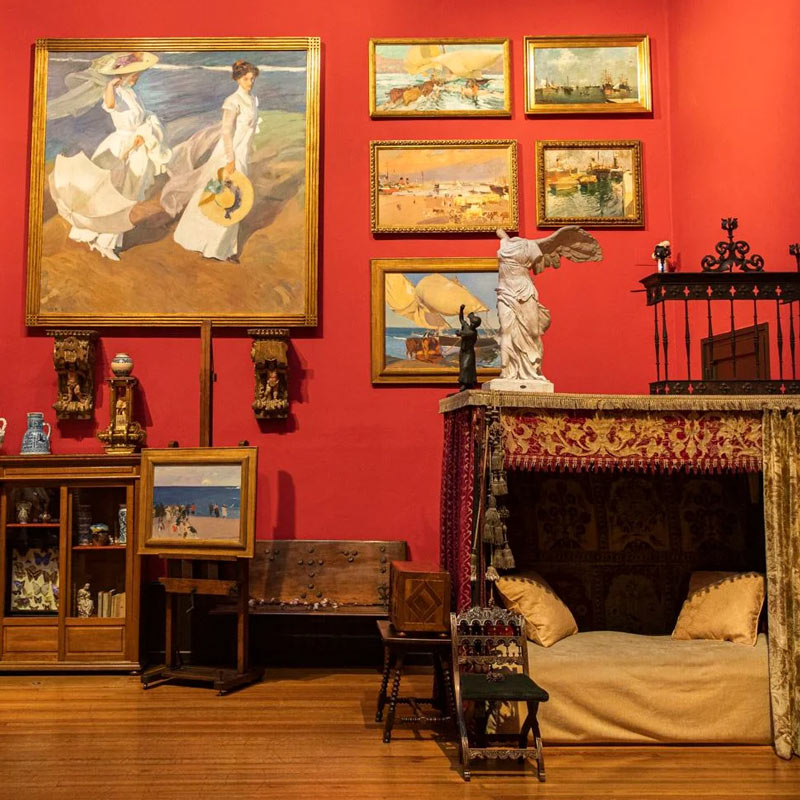Joaquín Sorolla: El Maestro de la Luz
This is a custom heading element.
Gracias a esta efeméride, los estudiantes de Hablamos han podido disfrutar, junto a todos los madrileños, de numerosas exposiciones temporales dedicadas a este genial pintor.
¿Quieres saber quién fue Sorolla y cuales son sus obras más conocidas? Quédate porque en el blog de Hablamos, escuela de español en Madrid, te lo contamos todo.
Joaquín Sorolla: el Maestro de la Luz
Joaquín Sorolla (1863-1923) es uno de los pintores más destacados de la historia del arte español, es reconocido por su habilidad magistral para capturar la luz y la vida en sus lienzos. Por ello se le conoce con el sobrenombre de “Maestro de la Luz”.
Su estilo impresionista es inigualable y fácilmente reconocible en todas sus obras. Su talento innato le permitieron crear obras que transmiten vitalidad y emoción. Podemos destacar de su vasta producción obras como “La Vuelta de la Pesca”, “Paseo a orillas del mar”, “Niños en la playa” o “Bañistas en la playa de Valencia”. Cada una de estas pinturas demuestra la maestría de Sorolla para retratar escenas costumbristas y sus inigualables habilidades técnicas en la representación de la luz y el movimiento.
Su obra maestra: “La Vuelta de la Pesca”
“La Vuelta de la Pesca” es considerada la obra maestra de Sorolla y una de las más sobresalientes del arte español. Concluida en 1894, esta pintura al óleo sobre lienzo muestra a un grupo de pescadores regresando a la playa tras una jornada de trabajo en el mar. La luz del sol baña la escena, generando reflejos brillantes en el agua y realzando los colores vivos de los ropajes y los rostros de los pescadores. La composición logra transmitir una sensación de movimiento y vida, capturando un instante lleno de energía y autenticidad.
Sorolla era un maestro en la representación de la luz y el agua, y “La Vuelta de la Pesca” es un ejemplo perfecto de su destreza en este aspecto. La obra transmite la alegría del retorno seguro de los pescadores y, al mismo tiempo, nos invita a reflexionar sobre la dureza del trabajo y la vida en el mar. Es un testimonio de la habilidad única de Sorolla para capturar momentos cotidianos con una pincelada vibrante y una sensibilidad excepcional.
No solo un pintor
Sorolla no solo fue un pintor sobresaliente, también se destacó en el mundo de la fotografía. Aunque es menos conocida que su faceta pictórica, la fotografía fue una pasión importante en la vida del artista. Sorolla utilizaba la cámara como una herramienta para capturar instantáneas de escenas cotidianas, paisajes y retratos de familia. Sus fotografías reflejan la misma sensibilidad artística y habilidad para capturar la luz que se observa en sus pinturas. A través de la fotografía, Sorolla experimentaba con la composición y el juego de luces y sombras, explorando nuevas formas de expresión visual. Su pasión por la fotografía no solo enriqueció su visión artística, sino que también le permitió documentar momentos preciosos y cotidianos de su vida y de la sociedad de su tiempo.
Entre sus fotografías más conocidas podemos destacar el retrato de familia: una foto donde puede verse a toda la familia, tomando café después de comer. Una foto natural, sin posar… ¡muy actual!
Su Casa Museo ¡está en Madrid!
Para los amantes del arte y los seguidores de Sorolla, la Casa Museo de Madrid es un lugar imprescindible para sumergirse en su vida y obra. Ubicada en el número 37 de la calle General Martínez Campos en Madrid, la casa fue la residencia del pintor y ahora alberga una valiosa colección de sus trabajos, así como objetos personales.
El museo ofrece a los visitantes una visión real de la vida y el ambiente en el que vivió y trabajó Sorolla. Las diferentes salas están decoradas con muebles de época y albergan una variedad de pinturas, bocetos y cerámicas del artista. También puede visitarse el taller donde el maestro pintaba y ver sus pinceles y botes de pintura en el mismo estado en el que los dejó hace 100 años.
La Casa Museo de Madrid también ofrece exposiciones temporales y actividades educativas, lo que la convierte en un espacio dinámico para conocer en profundidad la vida y el legado de este brillante artista español.
Y como extra, el pequeño jardín que rodea la casa añade un toque de belleza adicional. ¡Es una delicia sentarse en uno de sus banquitos a planear dónde ir después mientras disfrutamos de la sombra de sus centenarios árboles!
¿Quieres conocer más sobre Joaquín Sorolla y admirar sus obras en su Casa Museo? Pues apúntate a nuestros cursos de español en Madrid y disfruta de las actividades culturales gratuitas que ofrecemos todas las semanas.
Un paseo por el Parque Natural de Cabo de Gata
This is a custom heading element.
Le hemos preguntado a Olga, profesora de Hablamos, cuál sería su lugar ideal para las vacaciones y esto es lo que nos ha contestado.
Un paseo por el Parque Natural de Cabo de Gata
En verano hace bastante calor en España, así que la mayoría de los españoles cogen sus vacaciones en agosto para ir a la playa.
Yo soy de un pueblo de Almería (Andalucía) y os voy a hablar de una reserva natural repleta de playas vírgenes situada en esta provincia: El Parque Natural de Cabo de Gata-Níjar. ¿Habéis escuchado hablar alguna vez de este lugar? Os dejo un enlace para que podáis ver todo lo que podéis hacer en este maravilloso entorno: https://www.cabogataalmeria.com/
La provincia de Almería cuenta con 217 kilómetros de costa donde podemos encontrar playas aisladas formando preciosas calas, playas en núcleos urbanos y playas acreditadas con bandera azul. Muchas de ellas son de difícil acceso y, además, es necesario llegar a pie, ya que, al formar parte de un entorno natural, no se permite el acceso directo con el coche; sin embargo, también existen playas accesibles para personas con movilidad reducida, por eso, es importante estar informado para organizar bien la visita y disfrutar al máximo de la estancia.
Dado que nos hallamos en una reserva natural, tendremos que tener en cuenta que seguramente en nuestra playa no tengamos ni un baño ni una cafetería donde reponer fuerzas, así que lo normal es ir preparado con una mochila donde pondremos suficiente agua y comida para aguantar bien el día, y una buena protección solar. Intentaremos no llevar muchísimas cosas como, por ejemplo, sillas, sombrillas enormes, neveras de playa, raquetas, juegos, etc., ya que para acceder a algunas playas tendremos que caminar unos 10 o 15 minutos y podría ser bastante complicado.
Dentro del Parque Natural de Cabo de Gata-Níjar podemos encontrar 15 playas y 7 calas. Todas de agua cristalina, tanto que a veces puedes disfrutar del baño rodeado de peces, así que no olvides tus gafas de bucear porque vas a tener unas vistas espectaculares.
Si os tuviera que recomendar un listado de playas basándome en su belleza y su entorno, os diría la playa de los Genoveses, la playa de Mónsul, la playa de los Muertos (votada como una de las mejores playas de España), la playa del Barronal (frecuentada por personas naturistas que disfrutan de este entorno totalmente virgen practicando el nudismo), la playa de los Escullos y las playas de las Salinas y la Fabriquilla. En lo que se refiere a las calas (pequeñas playas donde bañarse resguardado del viento y de las multitudes), añadiría la cala de En medio, la cala San Pedro, la cala Rajá y la cala del Plomo. En estas playas y calas podemos encontrar dunas de arena fina y dorada, agua cristalina, acantilados y vistas maravillosas.
Una cosa muy importante que tenéis que tener en cuenta a la hora de planear vuestra estancia en la playa es el tiempo meteorológico del día y, sobre todo, la intensidad del viento, ya que, si se trata de un día con mucho viento de Levante, será necesario elegir una cala resguardada y evitar llevar una sombrilla porque el temido viento de Levante es bastante molesto a la hora de bañarse y tomar el sol.
A continuación, os dejo un vídeo subtitulado en español con más información del Parque Natural:
Solo me queda desearos un buen verano y ya me contaréis qué os han parecido nuestras playas. ¿Hablamos?
¡Viva la canción del verano!
This is a custom heading element.
Sea como fuere, seguro que cerca de donde estás ahora hay música y lo más seguro es que esté sonando la Canción del Verano. Pero… ¿Es la canción del verano un fenómeno universal? ¿Hay también canción del verano en España? ¡Quédate a descubrirlo con Hablamos, la escuela de español en Madrid!
La Canción del Verano en España: Un Fenómeno Musical
Cada verano en España, una canción se adueña de las radios, las discotecas y las listas de reproducción de millones de personas. Es la “Canción del Verano”, un fenómeno musical que se ha convertido en una tradición arraigada en nuestra cultura. Pero, ¿cuál es la historia detrás de esta popular tendencia en nuestro país?
La historia de la Canción del Verano en España se remonta a décadas atrás, cuando artistas como Peret y Georgie Dann lanzaron éxitos pegajosos que capturaban el espíritu festivo y alegre de la temporada estival. Canciones como “Borriquito” y “La Barbacoa” se convirtieron en himnos veraniegos, animando a la gente a bailar y disfrutar del buen tiempo. ¡Hasta hoy en día la gente más joven conoce las Canciones del Verano de esa época! Si no te lo crees, dile a tu profesor de español para extranjeros si conoce “Eva María” de Formula V.
En los años 90, el fenómeno de la Canción del Verano se hizo aún más relevante en España. Los del Río o King África hicieron historia con sus temas contagiosos y coreografías icónicas. ¿Quién no conoce canciones como “Macarena” o “La Bomba”? Estas canciones llenaron las pistas de baile y las fiestas de verano de toda España, incluso se convirtieron en auténticos fenómenos de masas llegando a otros países y haciendo bailar hasta al presidente de EEUU.
Con la llegada del nuevo milenio, la Canción del Verano en España siguió evolucionando y adaptándose a los cambios en la industria musical. Es entonces cuando aparecen David Bisbal o Enrique Iglesias. Con canciones románticas pero muy bailables, conquistaron las listas de éxitos veraniegas. Temas como “Bulería” y “Bailando” se convirtieron en verdaderos himnos del verano español.
En la actualidad, el auge de las redes sociales y las plataformas de streaming ha amplificado la influencia de la Canción del Verano en España. Ahora se escuchan temas de Rosalía o Aitana y sus temas, como “Malamente” o “Teléfono”, han dejado su marca en los veranos españoles.
La música urbana y el reggaetón han desempeñado un papel importante en la escena de la Canción del Verano de los últimos años. Este verano, nuestros estudiantes de los cursos intensivos de español escuchan cada fin de semana a artistas como J Balvin, Bad Bunny y Daddy Yankee, que combinan ritmos contagiosos que invitan al baile y con letras pegajosas que nuestros alumnos se esfuerzan por comprender.
¿Y este año? En las listas de éxitos del verano elaboradas por las cadenas musicales más influyentes de España destacan temas como “Las Babys” de Aitana, “Nochentera” de Vicco o “El Tonto” de Lola Índigo y Quevedo.
La Canción del Verano en España es un fenómeno que ha dejado huella en nuestra cultura musical. A lo largo de los años, ha evolucionado y se ha adaptado a los cambios en la industria. Y aunque en las listas de éxitos aparezcan canciones populares de artistas conocidos, muchas veces aparecen Canciones del Verano que no siguen las corrientes actuales, canciones que recuerdan a esas primeras etapas de la Canción del Verano, canciones que están grabadas por artistas amateurs en el ordenador de su casa, pero que cumplen con los requisitos de una buena canción del verano: transmitir la alegría y la energía de esta época del año, llenar las pistas de baile en las fiestas de los pueblos e instalarse en nuestras cabezas durante todas las vacaciones.
¡Que suene la Canción del Verano y que viva la música en España!
Present Tense – Forms and Uses
This is a custom heading element.
Verb Types and Pronouns
As you may or may not know, in Spanish there are three endings of the infinitivo (infinitive). These are –ar, -er and –ir. For example, the verb hablar means to talk/speak, comer means to eat and vivir means to live. Why is this important? Well, the structure of all Spanish tenses revolves around the idea of changing the endings of the verbs and this is different depending on which type of verb it is. You’ll also need to know the pronombres personales (personal/subject pronouns) too. Here they are in Spanish and English.
| Spanish | English |
| Yo | I |
| Tú | You (singular/informal) |
| Él/Ella/Usted | He/She/You (singular/formal) |
| Nosotros | We |
| Vosotros | You (plural/informal) |
| Ellos/Ellas/Ustedes | They (male plural)/They (female plural)/You (plural/formal) |
Presente de indicativo - -ar/-er/-ir
Now we have all that sorted, let’s look at the basic structure of the presente de indicativo (present simple) in Spanish. You simply take whichever verb you want, for example hablar, remove the ending so we are left with the stem which in this case would be habl- and then add on the correct person ending. Simple! Here’s a table to show you how it’s done.
| Person | -AR verbs (Hablar > Habl) |
-ER verbs (Comer > Com) |
-IR verbs (Vivir > Viv) |
| Yo | -o | -o | -o |
| Tú | -as | -es | -es |
| Él/Ella/Usted | -a | -e | -e |
| Nosotros | -amos | -emos | -imos |
| Vosotros | -áis | -éis | -ís |
| Ellos/Ellas/Ustedes | -an | -en | -en |
If we want to say He eats we can go to the Comer (to eat) column, look down at the él/ella/usted line and see that we need to add –e to the stem Com- which becomes come. There you go – you’ve just conjugado (conjugated) your first verb in Spanish! One thing we should say here is that in Spanish we often omit the personal pronouns as they are not really necessary unless we want to emphasise something. For instance, I live looks like it should be Yo vivo but really we would only say Vivo as the ending –o tells us who we are talking about.
The table above applies for all regular –ar/-er/-ir verbs, so you can very easily make lots of phrases simply by using it and thinking about which person you want to talk about.
When the rules don’t apply
Like with any language, Spanish verbs don’t all follow the same rules, and many have either spelling changes or are stem-changing. What does that mean? Ok, so we said that the stem of hablar (to live) is habl-, so the verb comenzar (to start) should be comenz- for all forms of the present, right? Wrong! When we want to say I start we need to say Comienzo, not comenzo. This is an example of the sorts of changes we have to be careful with in the presente de indicativo (present simple) in Spanish. Let’s look at them in more detail.
Spelling Changes in the presente de indicativo
For some verbs (which you’ll just have to learn as you go along), in the Yo (I) form, the spelling changes so that we can preserve the right pronunciation. Here are the main groups of verbs which do this and an example for each one.
- Verbs ending in –guir change to –go in the Yo form
- Extinguir (to extinguish) > extingo (I extinguish)
- Verbs ending in –ger or –gir, the g changes to j in the Yo form
- Coger (to take) > Cojo (I take)
- Dirigir (to direct) > Dirijo (I direct)
With this sort of verbs, all the other forms follow the normal spelling so it’s only for the Yo form we have to remember the exception.
Stem-changing Verbs
Although the terminology sounds a bit complicated, this really isn’t difficult to understand so don’t ever let big grammar words scare you! All this means is that we have to change the part of the verb we add the present endings to, and even then only in the yo (I), tú (you), él/ella/usted (he/she/you formal) and ellos/ellas/ustedes (they/you formal plural) forms. We never change the nosotros (we) or vosotros (you informal plural) forms.
The main changes we make are the following:
- e in the last syllable of the stem becomes ie
- e.g. querer (to want) > quiero
- e in the last syllable of the stem becomes i
- e.g. pedir (to ask for/order) > pido
- i in the last syllable of the stem becomes ie
- e.g. adquirir (to acquire) > adquiero
- o in the last syllable of the stem become ue
- e.g. dormir (to sleep) > duermo
- u in the last syllable of the stem becomes ue
- e.g. jugar (to play) > juego
To make this all a bit clearer, here is the verb querer (to want) shown with all its changes. You can then apply the same idea to whichever stem-changing verb you need.
| Person | Spanish | English |
| Yo | Quiero | I want |
| Tú | Quieres | You want |
| Él/Ella/Usted | Quiere | He/She wants /You want (formal) |
| Nosotros | Queremos | We want |
| Vosotros | Queréis | You want (plural informal) |
| Ellos/Ellas/Ustedes | Quieren | They want/You want (plural formal) |
Irregular ‘Yo’ forms
As well as the spelling changes we’ve talked about, there are also some verbs which have an irregular ‘Yo’ form but the other forms are regular. Here’s a few of them to get you started.
| Infinitive | Spanish | English |
| Caer (to fall) | Caigo | I fall |
| Conocer (to know) | Conozco | I know |
| Dar (to give) | Doy | I give |
| Hacer (to do/make) | Hago | I do/make |
| Saber (to know) | Sé | I know |
| Ver (to see) | Veo | I see |
Irregular verbs
Finally, we need to mention those verbs that seem to just do whatever they want and are almost totally irregular. These are often verbs we commonly use, so you’ll need to memorise them and accept that they are special and unique. A few you will need to know early on when learning Spanish are:
| Person | Ir (to go) | Ser (to be) | Tener (to have) |
| Yo (I) | Voy | Soy | Tengo |
| Tú (You informal) | Vas | Eres | Tienes |
| Él/Ella/Usted (He/she/You plural) | Va | Es | Tiene |
| Nosotros (We) | Vamos | Somos | Tenemos |
| Vosotros (You plural informal) | Vais | Sois | Tenéis |
| Ellos/Ellas/Ustedes (They/You plural formal) | Van | Son | Tienen |
Wow, that’s a lot of information! You’ll need some time to take it all in, but that’s what learning a language is all about – practising and experimenting with the grammar and vocabulary until you get it right. Here at Hablamos your teachers can help you better understand all this and use it in an effective, communicative way. Why not come and try one of our courses and get speaking Spanish right away? Hablamos – full-on Spanish!
Para gustos los colores
This is a custom heading element.
Todos los colores del arcoíris
Vamos a empezar aprendiendo los colores que se aprenden en un curso básico de español.
| Amarillo | Yellow |
| Azul | Blue |
| Blanco | White |
| Gris | Grey |
| Marrón | Brown |
| Morado | Purple |
| Naranja | Orange |
| Negro | Black |
| Rojo | Red |
| Rosa | Pink |
| Verde | Green |
Estos colores pueden tener matices. Por ejemplo, podemos expresar su tonalidad con oscuro (dark) o claro (light), con pastel (pastel) o chillón / fosforito / fluorescente (fluorescent).
También podemos describir los colores usando algún objeto que tenga ese mismo tono. Así encontramos el azul marino, el azul cielo, el amarillo limón, el rosa chicle o el verde hierba.
Y a veces los colores tienen nombres especiales como el celeste (azul claro), el lila (morado claro), el granate (rojo oscuro) o el beige (marrón muy claro).
Conocer el nombre de todos los colores (¡y recopilarlos en este blog de español) es una tarea muy complicada. Además, ¿sabías que hay colores que se dicen diferente en España y en Sudamérica? Por ejemplo: el marrón, en muchos países de América Latina se denomina café, y el rosa, rosado.
La gramática de los colores
Los colores son unas palabras un poco especiales ya que pueden funcionar como sustantivos masculinos o femeninos o como adjetivos.
Cuando hablamos del color, lo usamos como un sustantivo masculino singular.
- ¿Cuál es tu color favorito, Leo?
- Pues… Me encanta el rojo
Si nos referimos a un grupo de colores tendremos que usar la versión masculina plural.
- La gama de los rosas te sienta muy bien a la cara.
- Cuando llegué a Costa Rica me sorprendió la cantidad de verdes que existen en la naturaleza.
Algunos colores son nombres propios como Blanca, Violeta o Rosa.
- Mi amiga Blanca vino ayer a casa a cenar.
- ¡Violeta! ¡Cuánto tiempo sin verte!
Cuando el color acompaña a un nombre, se convierte en un adjetivo. Los adjetivos siempre concuerdan en género y número con el nombre al que acompañan y en la mayoría de los casos se escriben detrás del sustantivo:
- Me gusta la camisa blanca.
- ¡Mira esos pantalones rojos!
¿Recuerdas las reglas del género y número? Vamos a ver la que afecta a los colores que terminan en -o: amarillo, blanco morado, negro y rojo.
| Singular | Plural | |
| Masculino | -o rojo |
+s rojos |
| Femenino | -a roja |
+s rojas |
El resto de los colores que hemos estudiado (azul, gris, marrón, naranja, rosa y verde) tienen la misma forma en femenino y masculino, pero si cambian en singular y en plural.
| Singular | Plural |
| vocal naranja |
+s naranjas |
| consonante azul |
+es azules |
¿SER o ESTAR?
Es una buena pregunta que siempre llena las clases de español ya que la diferencia entre SER y ESTAR siempre es complicada de entender.
Cuando con el color queremos describir características, usamos el verbo SER:
- Todas mis camisetas son azules
- Mi perro Pancho es blanco y negro
Cuando usamos el color con el verbo ESTAR indicamos un estado y no una característica.
- Has tomado demasiado el sol y ahora estás muy rojo.
- María estaba blanca. Seguramente le dio una bajada de tensión.
Hablando con colores
Seguro que si estás en España o vas a venir a estudiar español en Madrid habrás oído frases como: “me he puesto morado a helado” o “eres más raro que un perro verde”. Y es que, a veces usamos los colores dentro de expresiones coloquiales para hablar de sentimientos, estados de ánimo y muchas más situaciones de la vida cotidiana. Si quieres conocerlo te invitamos a que visites nuestra entrada de “Aprende expresiones con colores”.
Y si aún tienes dudas y quieres conocer más sobre los colores en español, ¡apúntate a estudiar español en Madrid con Hablamos!
¿Estudiar español en España? ¡Por supuesto!
This is a custom heading element.
Si estás interesado en aprender o mejorar tus habilidades en español, no hay mejor lugar para hacerlo que en España, el país donde este idioma tiene su origen. Estudiar español en España ofrece numerosas ventajas que van más allá de la simple adquisición de conocimientos lingüísticos. ¿Te quedas a descubrirlas?
Inmersión total
Una de las mayores ventajas de estudiar español en España es la oportunidad de sumergirse completamente en el idioma. Estarás rodeado de hablantes nativos y tendrás la oportunidad de practicar el español en situaciones cotidianas, como en tiendas, restaurantes y con la gente local. Esta inmersión lingüística acelerará tu aprendizaje y te ayudará a adquirir fluidez y confianza en el idioma de manera más rápida y efectiva.
En Hablamos contamos con profesores nativos con una gran trayectoria profesional que te acompañarán durante el proceso de aprendizaje y te ayudarán en tu día a día para hacer que tu estancia idiomática en España sea lo más beneficiosa posible.
En la variedad está el gusto
España es un país diverso y multicultural, y cada región tiene su propio acento, expresiones coloquiales y maneras de expresarse en español. Estudiar español en España te brinda la oportunidad de familiarizarte con la riqueza de la lengua española y de experimentar diferentes formas de hablar. ¡Y Madrid es el punto de unión de todos los acentos!
Al vivir en una ciudad cosmopolita y acogedora como Madrid, no solo conocerás el acento y personalidad de los madrileños, también de otras personas de España, de Latinoamérica y del extranjero que ya forman parte de la cultura madrileña.
Y hablando de cultura
España es un país con una rica herencia cultural y artística. Al estudiar español en España, tendrás acceso directo a una gran variedad de recursos culturales. Podrás visitar museos, galerías de arte, teatros y monumentos históricos que te ayudarán a comprender mejor la historia y la cultura del país. Además, podrás participar en festivales, eventos y actividades culturales que enriquecerán tu experiencia y te sumergirán en la vida cotidiana española.
Y si lo tuyo no son los museos, no te preocupes. También conocer la vida cotidiana de los españoles y su gastronomía forma parte de nuestra cultura.
En Hablamos realizamos todas las semanas dos actividades culturales, una en línea y otra presencial, donde te acompañaremos a conocer los rincones más interesantes de Madrid y las curiosidades más divertidas de España. En las actividades culturales que ofrecemos podrás conocer a otros estudiantes de la escuela, de distintas nacionalidades y niveles, pero con el mismo interés por el idioma que tú.
Viajar y descubrir
Y si Madrid se te queda corto, ten en cuenta de que la capital de españa se encuentra estratégicamente ubicada en España y Europa. Desde Madrid puedes viajar y explorar otras ciudades cercanas usando la red de trenes de alta velocidad. O descubrir otros países europeos gracias a la oferta de vuelos baratos desde el aeropuerto internacional más grande de España.
En Hablamos conocemos la importancia de viajar. ¡Pregunta a tu profesor! Estará encantado de recomendarte lugares y ayudarte en la planificación de tu próxima escapada.
Experiencia de vida única
No sabemos todavía cuales son tus motivaciones para estudiar español: puede que estés interesado en los beneficios del español para su uso en el entorno laboral, quizá te interese el fútbol, el flamenco, el cine, la historia o la cultura, es posible que decidas estudiar español por placer o para viajar. De lo que estamos seguros es que estudiar español en España no solo se trata de aprender español, también de tener una experiencia de vida única.
Durante tu estancia en España podrás sumergirte en el estilo de vida español, disfrutar de la deliciosa gastronomía, descubrir la vibrante vida nocturna y explorar hermosas ciudades y paisajes. Esta experiencia enriquecedora te permitirá no solo crecer académicamente, sino también personalmente.
Si estás interesado en estudiar español en España, desde Hablamos no podemos más que animarte. Obtendrás una inmersión total en el idioma, conociendo acentos, expresiones coloquiales de Madrid y otros lugares del mundo. Podrás experimentar de primera mano la cultura, la historia y la vida cotidiana de una de las capitales europeas más cosmopolitas. Contarás con profesores comprometidos con tu aprendizaje y actividades culturales gratuitas con las que poner en práctica todos tus conocimientos fuera del aula.
Así que, si estás considerando estudiar español en España, ¡no hay mejor lugar para hacerlo que en Madrid con Hablamos! ¡Escríbenos y consulta todas tus opciones con nosotros!
Descubre el Paisaje de la Luz de Madrid
This is a custom heading element.
Cuando vienes a estudiar español en España hay miles de cosas que pueden llamarte la atención ¡Menos mal que los profesores nativos de Hablamos están aquí para ayudar!
En el blog de hoy queremos compartir una de estas consultas traídas a clase por una de nuestras alumnas de español para extranjeros: ¿Qué es el Paisaje de la Luz?
Madrid y el Paisaje de la Luz
Aunque nuestra estudiante esperaba ver las calles llenas de luces como en Navidad, el Paisaje de la Luz no es un festival de bombillas.
El Paisaje de la Luz de Madrid es una denominación que se le ha otorgado a un conjunto urbano de la capital española que está formado por el parque del Retiro y el paseo del Prado. Recientemente, este espacio ha sido incluido en la lista del Patrimonio Mundial de la UNESCO, lo que significa que ha sido reconocido como un lugar de valor universal y de gran importancia cultural e histórica.
El parque del Retiro
El parque del Retiro es uno de los principales atractivos turísticos de Madrid y uno de los mayores espacios verdes de la ciudad. Este parque fue creado en el siglo XVII como jardín de recreo para la familia real y posteriormente se abrió al público en general.
En el Parque del Retiro podemos encontrar numerosos puntos de interés, como el Palacio de Cristal, el Estanque Grande, el Parterre, el Jardín de Vivaces y el Jardín de los Planteles.
El Palacio de Cristal es un hermoso edificio de cristal y acero que se encuentra en el centro del parque y fue construido en 1887. Actualmente es un espacio dedicado a exposiciones temporales de arte contemporáneo que depende del Reina Sofía. La entrada es gratuita y es uno de los lugares favoritos de nuestro alumnos más activos en Instagram.
El Estanque Grande es otra de las atracciones del parque. En él se pueden alquilar barcas y dar un paseo relajante mientras se disfruta de las vistas del parque desde el agua. Un plan muy divertido.
También se puede observar la Fuente del Ángel Caído, que es una de las pocas estatuas que representa al diablo de manera explícita.
El Parterre es un jardín de estilo francés que se encuentra frente al Palacio de Cristal y en él podemos encontrar numerosas estatuas que representan a reinas, diosas, poetas y otros personajes históricos. El Jardín de Vivaces, por otra parte, es un jardín botánico que cuenta con numerosas especies de plantas, algunas de ellas muy raras.
Finalmente, el Jardín de los Planteles es un jardín dedicado a la enseñanza y estudio de las plantas. En él podemos encontrar un herbario, un jardín de aromáticas y plantas medicinales, y un jardín de cactus y suculentas.
El Parque del Retiro de Madrid es un oasis urbano que ofrece numerosas atracciones y actividades para todo tipo de visitantes. Es un lugar ideal para pasear, hacer deporte, disfrutar de la naturaleza o simplemente relajarse y desconectar del bullicio de la ciudad.
El paseo del Prado
El Paseo del Prado de Madrid es una de las avenidas más emblemáticas de la ciudad, que se extiende desde la Plaza de Cibeles hasta la Plaza del Emperador Carlos V, ¡muy cerca de la escuela de español Hablamos!
En el Paseo del Prado se pueden encontrar numerosos edificios históricos y monumentos, como la Fuente de Neptuno, que se encuentra frente al Museo del Prado y que está considerada una de las fuentes más hermosas de la ciudad, o la Puerta de Alcalá, que es un monumento de estilo neoclásico situado en la Plaza de la Independencia.
Además, en el Paseo del Prado se encuentran algunos de los museos más importantes de la ciudad, como el Museo del Prado, que es uno de los museos más visitados del mundo y que cuenta con una de las colecciones de arte más importantes y completas del mundo en pintura europea, desde el siglo XII hasta principios del siglo XX.
También está el Museo Thyssen-Bornemisza, que cuenta con una colección de arte que abarca desde el siglo XIII hasta el siglo XX y que incluye obras de artistas tan importantes como Van Gogh, Degas, Rubens o Rembrandt, entre otros. El Real Jardín Botánico, donde se encuentra una colección de más de 5.000 especies diferentes de plantas, algunas de las cuales son muy raras y valiosas. Y el CaixaForum, que es un espacio cultural que acoge exposiciones temporales y actividades culturales para todas las edades.
Pasear por el Paseo del Prado es una de las actividades más recomendadas ya que es una de las zonas más interesantes de Madrid.
Si quieres conocer el Paisaje de la Luz y recorrerlo mientras aprendes español, no dudes en escribirnos. En Hablamos, escuela de español en Madrid, contamos con el mejor plan de actividades culturales gratuitas para todos nuestros estudiantes.
¿Sabías que…? Palabras del español con origen árabe
This is a custom heading element.
“El otro día, uno de mis alumnos de origen árabe me dijo que hay muchas palabras del español que son muy parecidas al árabe, su lengua materna. Yo le conté que el español tiene influencia de varias lenguas y que España se llamó al-Andalus durante casi 800 años.”
El origen del español
En la actualidad el español es una lengua que cuenta con millones de hablantes repartidos por todo el mundo. Es la segunda de las lenguas maternas más habladas del planeta por detrás del chino. Sin embargo no podemos olvidar que el español es el resultado de una mezcla de aportaciones de numerosas culturas que fueron dejando a lo largo de la historia rasgos de su propia lengua en nuestro idioma.
La etimología es la ciencia que estudia el origen de las palabras y en español contamos con palabras de origen romano, griego, germánico, y por supuesto, árabe. Estas son algunas de las palabras españolas de origen árabe más usadas en la actualidad.
Aceite
Uno de los productos estrella de España es el aceite. La palabra aceite deriva del árabe hispano azzáyt, que a su vez tiene origen en el árabe clásico azzayt. Significa zumo de la aceituna.
Aceituna
Claro está que, si aceite tiene origen árabe, aceituna también. El origen es el mismo: azzáyt, palabra al que se le añadió el sufijo -tuna, un diminutivo. De esta forma podríamos decir que aceituna significa pequeño aceite.
Almohada
¿Quién no sueña después de un duro día estudiando español en España con dormir una siesta sobre una esponjosa almohada? Esta palabra proviene del árabe andalusí mujadda. Al español actual ha llegado junto con el artículo determinado al. Al-mujadda o el cojín.
Alcohol
Esta palabra también tiene su origen en el árabe hispánico: Kuhúl. Esta palabra al principio se usaba para describir un cosmético a base de polvos de antimonio que empleaban las mujeres para pintarse los ojos. Este producto se obtenía a través de una disolución y con el tiempo, la palabra se empleó para referirse a cualquier producto elaborado por destilación.
Azúcar
El punto dulce que te pones en el café cada mañana usa en español una palabra de origen árabe. Azúcar proviene del árabe hispánico assúkkar y esta a su vez del árabe clásico sukkar.
Alfombra
Este es otro de los muchos arabismos que han quedado en nuestra lengua y que empiezan por al-. Una palabra de origen árabe al-hanbal, con la que se referían a una cubierta hecha con varios pedazos de pieles y a modo de tapiz.
Zanahoria
También zanahoria proviene del árabe hispánico: safunnárya. Esta palabra viene a su vez del griego y hacía referencia a las zanahorias silvestres.
Tabaco
Aunque el tabaco es una planta originaria de América que llegó a Europa mucho después de la ocupación árabe, el término tiene un origen árabe: tubbaq, una palabra con la que designaban determinadas plantas medicinales que marean al usarse.
Naranja
La palabra naranja es una de esas palabras que los árabes tomaron prestadas del sánscrito narangah, la cual significa árbol que da naranjas. Una palabra que pasó al persa como nārang y de ahí al árabe como nārang (al árbol) y nāranga (al fruto).
¿Te ha sorprendido este artículo? ¿Conocías el origen árabe de estas palabras? Recuerda que puedes aprender muchas más curiosidades en las actividades culturales de Hablamos, escuela de Español en Madrid.
¡Qué calor!
This is a custom heading element.
Los meses de julio y agosto son los meses de verano en Madrid. Generalmente se caracterizan por ser muy cálidos y soleados. Durante esta época del año la temperatura suele estar entre los 25ºC y los 35ºC, aunque recientemente estamos sufriendo olas de calor donde en las zonas centrales del día se pueden superar los 40ºC. Por las noches las temperaturas bajan, pero no por ello podrás librarte del calor ya que, en las ciudades, el calor nocturno mana de los edificios y calles.
Con temperaturas así es muy importante seguir una serie de recomendaciones para evitar golpes de calor: Beber suficiente agua, aunque no sientas sed, vestir ropa ligera y holgada, usar sombrero y protección solar, descansar en lugares frescos y evitar la actividad física en las horas de mas calor son algunas de ellas.
Y después de estas recomendaciones, ¿sabías que a los españoles nos encanta hablar del tiempo? Es un tema de conversación muy recurrente cuando te encuentras con un vecino en el ascensor, ¡incluso te valdrá para iniciar una animada conversación con los profesores y alumnos de nuestra escuela!
Vamos a ver algunas expresiones para charlar sobre el calor. ¡Prepara el abanico y empecemos!
¿Cómo decimos los españoles que tenemos calor?
No importa si estás en el metro, en un bar, o de camino a la academia de español. En todas partes escucharás expresiones con las que los nativos decimos el calor que hace. ¡Vamos a conocer algunas!
- Hace un sol de justicia -> El origen de esta expresión en bastante tétrico pues hace referencia a las penas judiciales que se hacían en la antigüedad donde se obligaba al reo a pasar largas horas bajo el sol, considerado una divinidad y, por lo tanto, quien debería impartir justicia.
- ¡Cómo pica/pega/aprieta Lorenzo! -> En España el sol se llama Lorenzo gracias a una canción infantil:
El sol se llama Lorenzo
y la luna Catalina;
Catalina anda de noche
y Lorenzo anda de día.
Al son que la repetía,
y al son que la repitió
Al tibiríon, tibirón - Hace tanto calor que… -> En España las comparaciones son muy comunes en el lenguaje coloquial. Si queremos hablar del calor podemos decir “hace tanto calor que puedes freír un huevo en la calle”, “hace tanto calor que se me derriten las ideas”, o nuestra favorita: “hace tanto calor que hasta las ranas llevan cantimplora”.
- Nos asamos -> ¿Alguna vez has hecho galletas y al abrir el horno el calor te ha dado una bofetada? Pues esa sensación es la que tendrás cuando abras las ventanas en verano. Ya no volverás a mirar las galletas con la misma cara.
Si quieres conocer más expresiones y aprender a usarlas como todo un nativo, no dudes en apuntarte a las clases de español para extranjeros en la escuela de español Hablamos, tu academia de español en Madrid. Y si las altas temperaturas te dan miedo, recuerda que también puedes disfrutar de nuestras clases de español con profesores nativos en formato on-line durante todo el año. ¡Haz nuestra prueba de nivel y pide más información!
El Camino de Santiago: Una experiencia inolvidable de peregrinación
This is a custom heading element.
¿Conoces el Camino de Santiago?
El Camino de Santiago es una ruta de peregrinación considerada una de las más famosas e importantes del mundo. Con una historia rica y una belleza natural impresionante, esta ruta ofrece una experiencia única que deja una huella profunda en todos aquellos que se aventuran a recorrerla.
Su historia se remonta al siglo IX cuando se descubrió la tumba del apóstol Santiago en la ciudad de Santiago de Compostela. Desde entonces, miles de personas, que reciben el nombre de peregrinos, han caminado por esta ruta en busca de una experiencia espiritual, cultural y personal.
Con más de 800 kilómetros de distancia, el Camino Francés es la ruta más popular que parte de la ciudad francesa de Saint-Jean-Pied-de-Port. Esta ruta atraviesa los Pirineos y pasa por pueblos y ciudades históricas como Logroño, Burgos, León, y finalmente llega a Santiago de Compostela. Sin embargo, no es el único camino. Hay otras rutas menos conocidas desde otros puntos: el Camino Inglés, el Camino de Invierno, el Camino del Norte, etcétera.
La peregrinación por el Camino de Santiago es mucho más que un simple viaje. Es una experiencia única para todo aquel que la realiza. Esta aventura puede ser realizada a pie, en bicicleta o incluso a caballo o en barco de vela. El ritmo y la distancia son elegidos por cada peregrino, lo que hace que cada experiencia sea única. Es una experiencia transformadora que implica desafíos físicos, introspección personal.
Tradicionalmente, el Camino de Santiago se realizaba por creencias religiosas. En la actualidad muchos continúan con esta tradición, pero más vinculada a la experiencia espiritual que muchos peregrinos buscan. Los peregrinos pueden tener momentos de introspección y reflexión mientras caminan por la ruta. Muchos peregrinos expresan que el camino les ayuda a encontrar la paz interior y a conectar con su fe o espiritualidad.
Otra de las cosas que más destaca del Camino de Santiago es el ambiente que se vive durante la ruta. Los peregrinos pueden encontrarse con una gran diversidad de personas de todo el mundo, que comparten su misma pasión por la ruta. Esto hace que muchos peregrinos hagan amistades durante el camino y que el ambiente sea muy acogedor.
El entorno también es impresionante. Durante la ruta, los peregrinos pueden disfrutar de hermosos paisajes, pueblos pintorescos y ciudades históricas. Además, la gastronomía y la cultura de España son otro atractivo del camino. En las diferentes regiones por las que pasa el camino, los peregrinos pueden catar vinos, probar quesos locales, comer platos típicos de la región y mucho más.
La ruta está llena de ermitas, iglesias y catedrales históricas que pueden ser visitadas por los peregrinos. El destino final y el lugar donde se encuentra la tumba del apóstol Santiago, la Catedral de Santiago de Compostela es, junto con el camino, Patrimonio de la Humanidad por la UNESCO y su fachada adorna la cara de las monedas de céntimo acuñadas en España.
La ruta también cuenta con una serie de rituales y tradiciones que forman parte de la experiencia del Camino de Santiago. En la Cruz de Hierro, en la provincia de León, todos los peregrinos dejan una piedra que han traído desde sus lugares de origen. Otro ritual es la tradición de sellar la credencial (una especie de pasaporte) con sellos y estampas en cada etapa del camino, demostrando que el peregrino ha recorrido la distancia correspondiente. Con esta credencial debidamente sellada el peregrino obtendrá la Compostela, una acreditación en latín que certifica que el peregrino ha completado la ruta.
El Camino de Santiago es un desafío físico y mental. La distancia y el terreno pueden resultar difíciles para algunos peregrinos, especialmente cuando se camina durante un largo período de tiempo. Pero el reto de alcanzar esta meta es lo que atrae a la mayoría de los peregrinos. Es una forma de superarse a uno mismo y demostrarse que se es capaz de lograr cualquier cosa que se proponga.
¿Te animas a unirte a nuestros estudiantes peregrinos? ¡Aprovecha tu estancia para estudiar español en España y prueba a realizar algunas de las etapas del Camino de Santiago!















